
Are High Heels Bad for Your Feet?
If you’ve ever worn heels over a couple of inches, then you’ve probably experienced the discomfort that kicks in after a while. There are ways to make it more bearable of course, but no matter what you do, after a full day (or night) in heels, you’ll be delighted to kick them off!
But what’s really fascinating, is that regardless of the discomfort signalling more sinister underlying issues, for many decades women have steadfastly held onto their heels.
This article explores the health risks of heels, the reasons why women continue to wear heels, and how we can take realistic steps to move towards more healthier footwear.

Podiatrist Disapproved
Take a quick look around the internet you’ll find podiatrists and other health professionals reporting a list of unpleasant conditions in their heels-wearing clients:
hammer toes, ingrown toenails, corns, plantar fasciitis, knee pain, hip problems, back pain, neck pain, headaches, and even digestive issues.
You may have experienced some of these conditions first hand or very likely watched family members go through them.
High Heels Affect the Whole Body
This image from Katy Bowman’s Simple Steps to Pain Relief, also shared on her blog¹ (originally from Rossi 2001²), shows how wearing high heels affects alignment.
On the left is a figure in bare feet or thin, zero drop shoes in correct anatomical alignment.
In the middle, a figure in high heels, still in correct alignment, but obviously about to fall over as a result.
The figure below shows how your alignment has to change in order to keep you upright whilst wearing heels. Compare it with the figure on the left to see the difference – knees, hips and stomach are thrown forward, whilst the upper body arches back, creating an exaggerated curve in the lower back and excessive curvature in the upper spine.
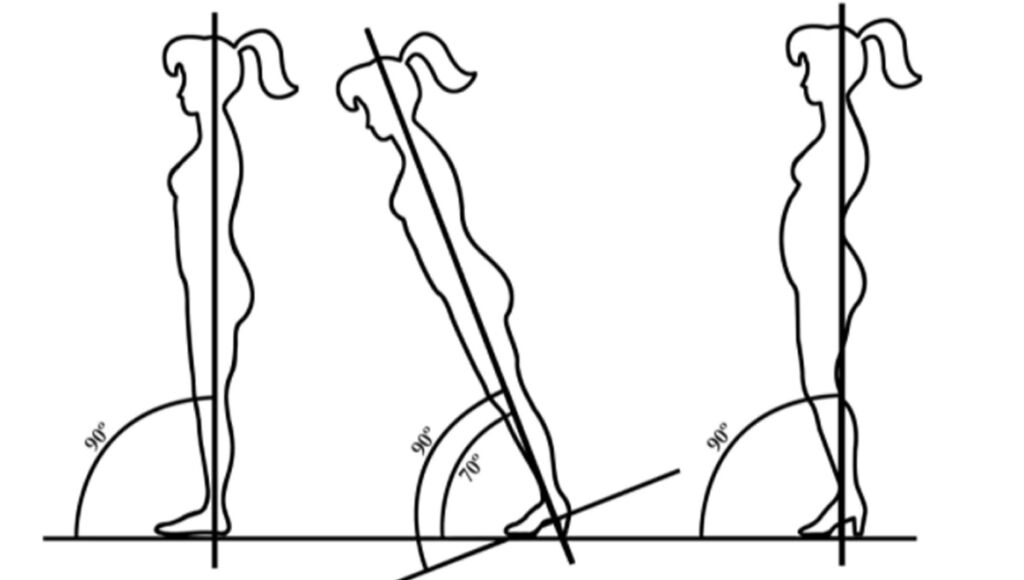
Katy Bowman, biomechanist, author, and movement educator, explains that a shoe with a high heel “compresses and degenerates the disks in the spine, weakens the pelvic floor, decreases the mineral density in the bones, and kills the nerves in the feet.”³
Scientifically Proven Health Problems
The scientific evidence backs this up with a number of health issues clearly associated with wearing high heels.
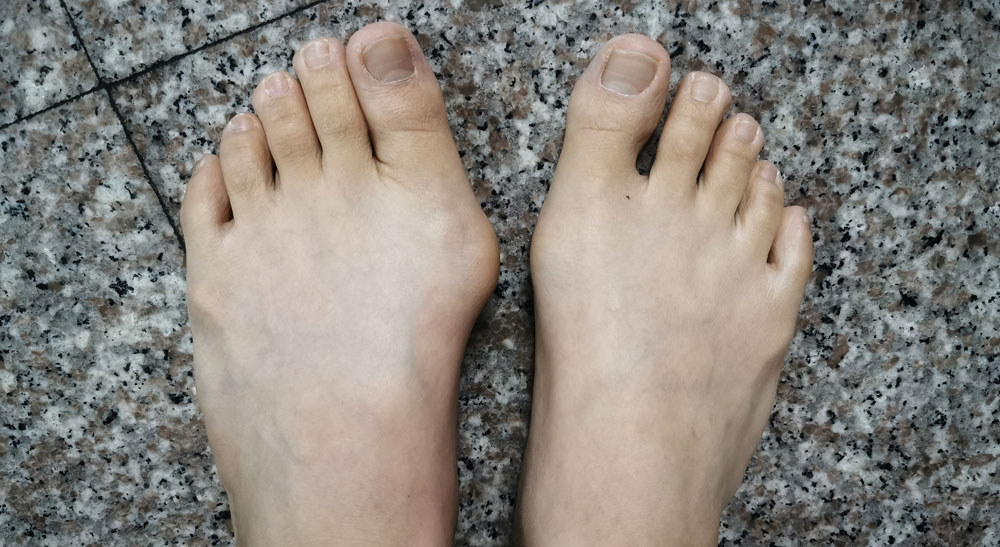
A systematic review of the scientific research into high heels, Barnish, Morgan & Barnish 2018, showed that wearing heels increases your risk of bunions, musculoskeletal pain and injuries⁴.
The research shows clear and significant biomechanical changes in the musculoskeletal system, which increases the risk of osteoarthritis due to the changes in pressure in your joints.
The authors also identified that the more you wear heels, the higher your risk of developing problems, and the higher and narrower the heels, the greater the risk of serious injury like ankle fracture.
Why Do People Still Wear Heels?
If you’d never worn heels, reading the information above might lead you to wonder why on earth anyone would ever wear them! It’s a good question, especially when you consider that wearing damaging and deforming footwear is nothing new.
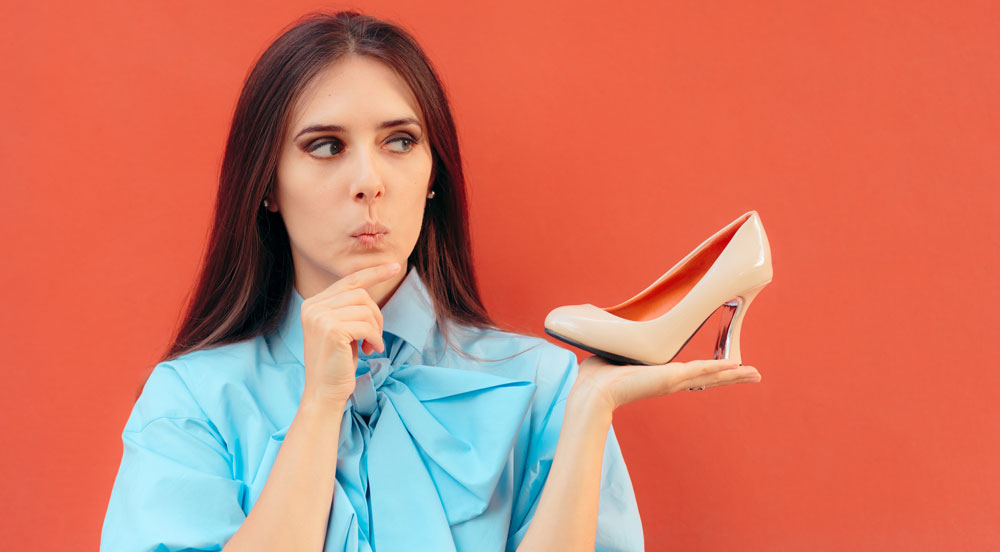
Most of us have heard the awful stories of foot binding in China which went on for hundreds of years. And did you know that pointed toe shoes were first worn 3000 years ago in Egypt as a status symbol? Eventually, the deformed shape of feet caused by wearing such shoes became a status symbol in its own right.⁵
Clearly psychosocial factors must be taken into consideration when helping people to make healthier choices about their footwear.
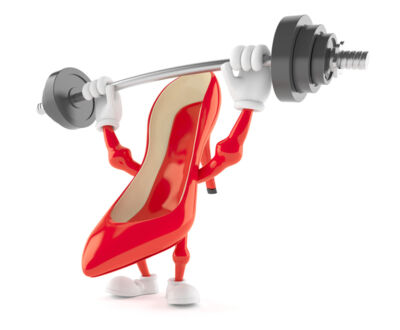 Heels Are More Than Just Shoes
Heels Are More Than Just Shoes
Historically, there have been powerful social factors which influenced people’s decisions on footwear and fashion in general.
Rossi 2001⁵ discusses the historical use of fashion at length in his fascinating article ‘Fashion and Foot Deformation’. He sums it up by saying:
“There is a significant message seeking to get through here: fashion is not a modern invention. It has been with us since the earliest civilisations. There is no mystery or ‘mystique’ about fashion. Nor is it flighty or frivolous or fickle or shallow. And least of all is it associated with ‘vanity’. It is, instead, a vital force of human nature and essential to our state of wellbeing and self image.”
He also quotes from The Unfashionable Human Body, by Bernard Rudofsky:
“Physical distress is accepted by women if it is a constitutional part of the pleasure of courtship and mating…women will furiously defend their high heels because any distress to their feet is in itself a form of attraction for men, many of whom feel it is a sacrifice made for them.”
Most of the recent scientific research into the psychosocial influences on footwear focuses on women as the largest demographic in recent history using high heels.
Barnish et al⁴ identified a number of factors that influenced women’s decisions to wear high heels, including both explicit and implicit formal dress codes which required women to wear high heels, but more importantly, they found evidence of clear psychological benefits associated with wearing heels.

Wearing Heels Makes You Feel Attractive
Like it or not, women feel more attractive when wearing heels and men respond differently to women wearing high heels.
It’s hardly surprising that women would internalise this association when they grow up constantly surrounded by images of attractive and successful women wearing high heels in high fashion, magazines, and advertising of all kinds.
But the idea of using clothes to change the way we feel and the way the world responds to us is something that is ingrained in culture worldwide. People have been using clothes as a status symbol for centuries.
Symbol of Success
The high heel in particular has long been associated with wealth and power, due to its association with royal figures like Queen Elizabeth I and King Louis XIV, and the fact that through the centuries only rich people, who did not work, could wear such shoes.⁶

Many of us alive today have our own memories of an explicit example of this during the 1970s/80s, when the term ‘power dressing’ was born. Primarily encompassing features which emulated men’s business suits, therefore allowing women to feel more confident entering into male dominated professional environments, the high heel fitted in perfectly with this concept as it made women feel taller, more confident and more authoritative.
 Heels Make You Feel Confident
Heels Make You Feel Confident
Although fashions have changed, the idea of power dressing has stayed with us over the decades as a way to feel more confident in work or social situations, and there’s definitely something to be said for the social advantages of portraying the right image in specific situations.
But as the business world evolves – tech companies leading the way with relaxed office attire – less formal dress codes allow us the freedom to re-evaluate the way we portray our image and, in particular, our footwear choices.
Because it’s not really about the shoes.
Express Your Innate Confidence
The shoes are only a vehicle that allows us to express the confidence that we already have inside.
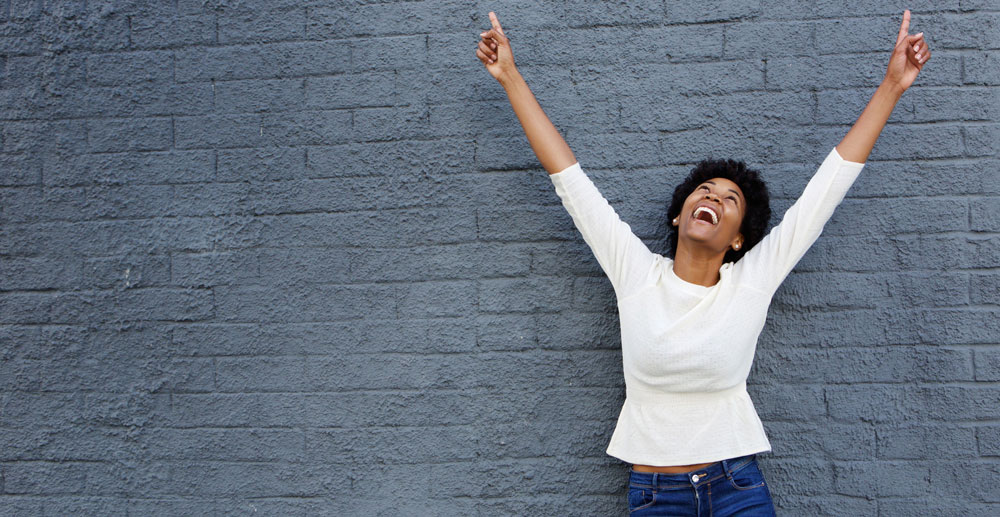
What if we could learn to access that confidence without damaging footwear? Perhaps we could get the same effect with other aspects of our clothing? Or perhaps we could find healthier shoes that we love, and feel great in, that also allow us to access that confident version of ourselves.
Find New Status Symbols
We love Ann Shoket’s (Former Editor in Chief of Seventeen and self-confessed Jane Goodall of Millenials) idea of exchanging the high heels status symbol for an Apple watch – finding new, more meaningful status symbols that are no longer harmful and restrictive, rather, that enable us to live our best lives.⁷
Create Your Own Beauty Standards
Summer Brennan, award winning investigative journalist and author, sums it up nicely – “We are in a decades-long process of finding out what a free woman can look and act like, which will probably take centuries more to determine.”⁸

Now is exactly the time that we all get to choose how to express ourselves, no matter what our gender, to reinvent our own ideas of what confidence looks like. We no longer have to pay the price of beauty – we finally have the freedom to create our own standards of beauty. And we are!
Flats are Becoming More Popular
A 2020 article in the Irish Examiner⁹ quotes market research statistics which clearly show over the last few years people have been voting with their feet and choosing more comfortable footwear, reflecting the 21st century move away from strict formal office wear and gender stereotypes.
Even the Cannes Film Festival, after the high heels controversy of 2015 when several ladies were refused entry due to wearing flats, has had to concede that women should be allowed to wear them.
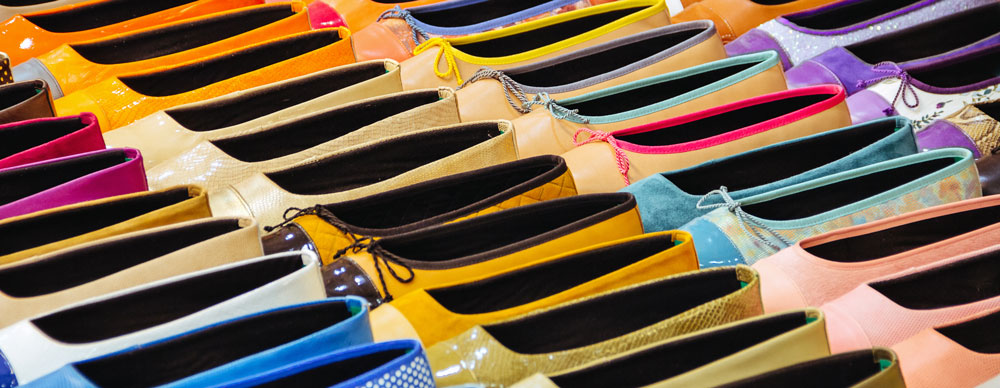
The 2015 incident sparked a backlash from celebs who came out in support of flats, including Julia Roberts, Emily Blunt, and Kristen Stewart, who famously removed her Louboutins in the middle of the red carpet.
Now, after many months of wearing comfortable footwear during the pandemic, the internet is rife with speculation about whether women in particular will return to heels and articles about how unpleasant wearing heels has become after time in more comfortable shoes.
Of course, once the pandemic passes and life returns to normal, the novelty of high heels may peak interest, but the pre-pandemic trends for comfortable footwear appear to be a sign of a much more permanent shift towards healthier shoes.
Tips to Reduce the Negative Impact of Heels
If you’re concerned, but not quite ready to give up your heels, Dr Emily Splichal, podiatrist & barefoot science expert, has some great advice¹⁰. Her tips are designed to offset some of the harm of high heels. She suggests:
- Opt for lower heels, ideally less than 3 inches.
- Ensure that the shoes fit properly.
- When you’re wearing heels, slow down a little and keep your stride short.
- Do hip mobility exercises regularly.
- Do some barefoot training.
We think this is a great place to start to improve your long term foot health.
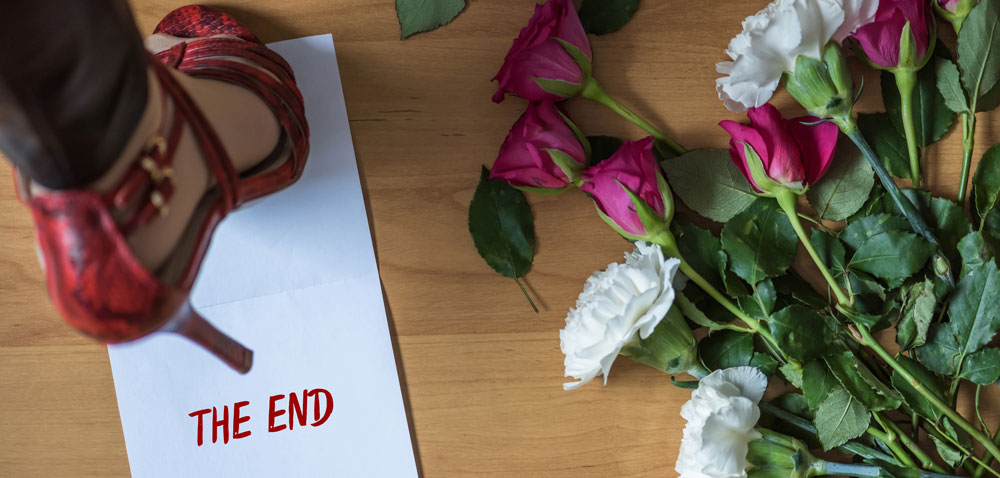
Reducing Heels Use
Dr Ray McClanahan, podiatrist, also has some useful suggestions¹¹:
- Kick off your heels under your desk
- Do stretches regularly
- Wear barefoot shoes and toe spacers whenever possible
- Challenge outdated dress codes
Take Your Time
Taking your time is really important. In her entertaining article ‘Dear Barbie’, Katy Bowman points out that years of high heels use lead to permanent changes in your body as it tries to adapt to the shoes.¹²
She advises against rapid changes in footwear, explaining that it takes time for your body to adapt back to lower heels. She suggests opting for a 1 inch heel for several months to encourage your body to regain lost function.

Replacing Your Heels
If you’re following expert advice and your feet are used to flats again, you could invest in some dressier barefoot shoes to help you move away from heels as your go-to. They may even come to replace your heels over time.
Beware of Hidden Heels
As you progress in your quest for more comfortable footwear, you may become aware that hidden heels are hiding everywhere…sports shoes, work shoes, dress shoes, ‘sensible’ shoes, children’s shoes, and even some shoes called ‘flats’ actually have a small heel!
Take a look at our article What Are Zero Drop Shoes to find out more.
References
- Bowman, K 4 fast fixes for pelvic floor disorder, viewed 16/11/2021<https://www.nutritiousmovement.com/4-fast-fixes-for-pelvic-floor-disorder/>
- Rossi WA, 2001, Footwear: The primary cause of foot disorders, Podiatry Management, viewed 08/12/2021 <https://www.correcttoes.com/foot-help/wp-content/uploads/2015/12/Rossi-FootwearTheprimarycauseofFootDisorders.pdf>
- Bowman K. Are high heels the cigarettes of the future? Viewed 29/11/2021 <https://www.nutritiousmovement.com/are-high-heels-the-cigarettes-of-the-future/>
- Barnish M, Morgan HM & Barnish J, 2018. The 2016 HIGh heels: Health effects and psychosexual benefits (high habits) study: systematic review of reviews and additional primary studies, BMC Public Health, 18: 37. <https://bmcpublichealth.biomedcentral.com/articles/10.1186/s12889-017-4573-4>
- Rossi WA, 2001, Fashion and foot deformation, Podiatry Management, viewed 08/12/2021 <https://www.correcttoes.com/foot-help/wp-content/uploads/2015/12/Rossi-FashionandFootDeformation.pdf>
- New York Post, 2015, “The history of high heels from Venic prostitutes to stilettos’, viewed 30/11/2021. <https://nypost.com/2015/01/25/the-history-of-high-heels-from-venice-prostitutes-to-stilettos/>
- Shoket A, 2018, How power dressing moved beyond the high heel, viewed 30/11/2021. <https://nypost.com/2015/01/25/the-history-of-high-heels-from-venice-prostitutes-to-stilettos/>
- Brennan S, 2019, Sex, power, oppression: why women wear high heels, viewed 30/11/2021. <https://www.theguardian.com/fashion/2019/mar/20/sex-power-oppression-why-women-wear-high-heels>
- O’Connor A, 2020, Are we walking away from high heels. Viewed 30/11/2021. <https://www.irishexaminer.com/lifestyle/fashionandbeauty/arid-40034555.html>
- Splichal E, 2015. Biomechanics of the Stiletto Strut, viewed 28/11/2021.
<https://barefootstrongblog.com/2015/03/10/biomechanics-of-the-stiletto-strut/>
- Hughes R & McClanahan R, 2012, High heeled diva, do what heals ya! Viewed 30/11/2021. <https://www.correcttoes.com/foot-help/high-heeled-diva-do-what-heals-ya/>
- Bowman K. Dear Barbie. Viewed 29/11/2021. <https://www.nutritiousmovement.com/dear-barbie/>
<https://barefootstrongblog.com/2015/03/10/biomechanics-of-the-stiletto-strut/>




Get Social…